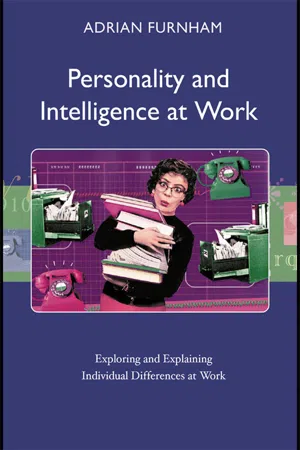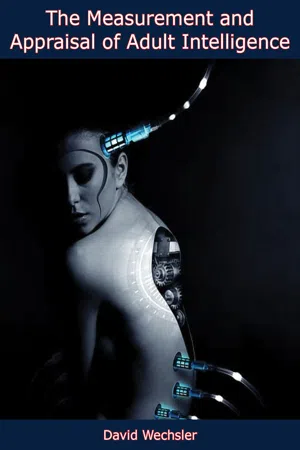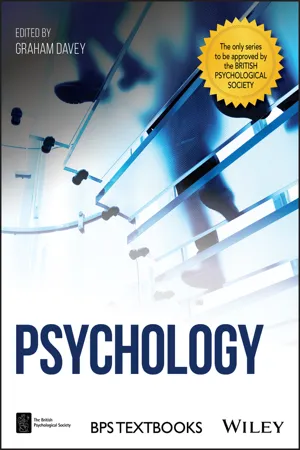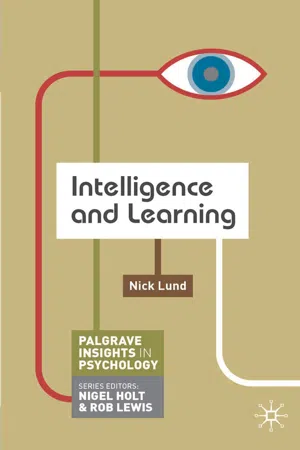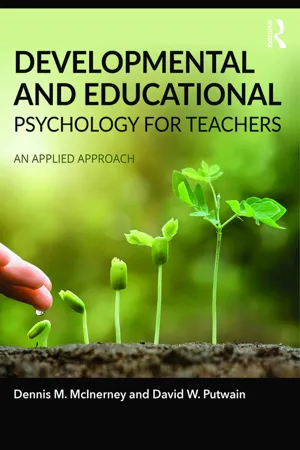Psychology
Intelligence
Intelligence refers to the ability to learn, understand, and apply knowledge to solve problems and adapt to new situations. It encompasses various cognitive abilities such as reasoning, problem-solving, and abstract thinking. In psychology, intelligence is often measured using standardized tests, but there are also multiple theories and perspectives on what constitutes intelligence.
Written by Perlego with AI-assistance
Related key terms
Related key terms
1 of 4
Related key terms
1 of 3
12 Key excerpts on "Intelligence"
- eBook - ePub
Personality and Intelligence at Work
Exploring and Explaining Individual Differences at Work
- Adrian Furnham(Author)
- 2008(Publication Date)
- Routledge(Publisher)
Box 6.1 ) is an excellent and clear statement on what psychologists think about Intelligence.Box 6.1Psychologists’ thoughts on IntelligenceThe meaning and measurement of Intelligence- Intelligence is a very general mental capability that, among other things, involves the ability to reason, plan, solve problems, think abstractly, comprehend complex ideas, learn quickly and learn from experience. It is not merely book learning, a narrow academic skill, or descriptive of test-taking smarts. Rather, it reflects a broader and deeper capability for comprehending our surroundings – “catching on”, “making sense” of things, or “figuring out” what to do.
- Intelligence, so defined, can be measured, and Intelligence tests measure it well. They are among the most accurate (in technical terms, reliable and valid) of all psychological tests and assessments. They do not measure creativity, character, personality or other important differences among individuals, nor are they intended to.
- While there are different types of Intelligence tests, they all measure the same Intelligence. Some use words or numbers and require specific cultural knowledge (such as vocabulary). Others do not, and instead use shapes or designs and require knowledge of only simple, universal concepts (many/few, open/ closed, up/down).
- The spread of people along the IQ continuum, from low to high, can be represented well by the bell curve (in statistical jargon, the “normal curve”). Most people cluster around the average (IQ 100). Few are either very bright or very dull: About 3% of Americans score above IQ 130 (often considered the threshold for “giftedness”), with about the same percentage below IQ 70 (IQ 70–75 often being considered the threshold for mental retardation).
- Intelligence tests are not culturally biased against African American or other native-born, English-speaking people in the USA. Rather, IQ scores predict equally accurately for all such Americans, regardless of race and social class. Individuals who do not understand English well can be given either a non-verbal test or one in their native language.
- David Wechsler(Author)
- 2020(Publication Date)
- Barakaldo Books(Publisher)
The view that we do not know what we are talking about when we speak of Intelligence is unfortunate not only because it is not true by any comparative standards—actually we now know more about Intelligence than we do about any other mental function—but because it has nurtured a confusing pessimism and a profitless kind of account taking which almost completely misses the issue at hand. The issue is not, as is commonly supposed, the lack of agreement by psychologists on a standard definition of Intelligence. If this were so, the problem might conceivably be resolved by an international convention, as has been done by physicists in defining various units of measurement. Unfortunately, the problem with which psychologists are concerned in defining Intelligence is quite different from that which the physicist deals with when he defines amperes, farads and watts, or the biologist when he classifies living things as plants and animals. The difficulty involved is similar to what the physicist encounters when asked to state what he means by time or energy, or the biologist what he means by life. The fact is that energy and life are not tangible entities but limiting constructs. You cannot touch them or see them under a microscope even though you are able to describe them. We know them by their effects or properties. The same is true of general Intelligence. It is not a material fact but an abstract construct. What we can reasonably expect of any attempt at definition is only a sufficiently clear and broad connotation as to what it comprehends. Mind you, not what it is but what it involves and eventually, what it distinguishes. Now that is precisely what the more effective definitions of Intelligence have sought to do, though sometimes too tersely and sometimes with too special emphasis. Thus, Intelligence has been defined as the ability to learn, the capacity to adapt to new situations, the ability to educe correlates, and so on. All these attempts to define Intelligence as some broad function comprehend varieties of behavior which might reasonably be called “intelligent,” although each from particular points of reference. The first might be more useful to the educator, the second to the biologist and the third to the psychologist. The pertinent question, however, is not whether Intelligence is the ability to learn rather than the ability to adapt or to educe relationships. It is all these and, as we shall see later, much more. Learning, adapting, reasoning and other forms of goal directed behavior are only different ways in which Intelligence manifests itself. But while Intelligence may manifest itself in a variety of ways, one must assume there is some communality or basic similarity between those forms of behavior which one identifies as intelligent. For example, we must assume there is something common to learning to count, avoiding danger and playing chess which makes it possible for us to say that they are evidence of intelligent behavior as against learning to walk, being accident prone and playing bingo, which seemingly have little if anything to do with it.- eBook - ePub
- Graham Davey, Christopher Sterling, Andy Field, Ian Albery, Chris Sterling, Ian Albery(Authors)
- 2014(Publication Date)
- Routledge(Publisher)
These are: analytic Intelligence (academic-based problem solving of problems with a single right answer which are assessable through Intelligence tests), creative Intelligence (reacting to and producing novel ideas) and practical Intelligence (required for day-to-day tasks that are often ill defined or have a number of potential solutions). Sternberg's theory, like that of Gardner extends the concept of Intelligence beyond traditional academic definitions and reflects the use of intellect in everyday life (see Focus points 30.4 and 30.5). Summary Psychometric and cognitive-contextual perspectives therefore seek to understand Intelligence in terms of underlying hypothetical constructs, whether these constructs are psychometric factors (e.g. mathematical ability), cognitive processes (e.g. memory retrieval) or are constructs defined by environmental context (e.g. survival and adaptation). These two perspectives also investigate the question of whether Intelligence is a single construct or is a combination of specific intellectual abilities. Important debate also revolves around the question of whether the definition of Intelligence should be flexible. Different cultures should have different definitions of what intellectual ability is and Intelligence should be determined to some extent by the environment in which it is being used (and for what purpose). There is one further issue driving psychological research into Intelligence - George McCloskey, Lisa A. Perkins, Bob Van Diviner(Authors)
- 2008(Publication Date)
- Routledge(Publisher)
Cognitive Psychology textbook:Intelligence is the capacity to learn from experience, using metacognitive processes to enhance learning, and the ability to adapt to the surrounding environment, which may require different adaptations within different social and cultural contexts. (p. 485)In Sternberg’s definition, the term metacognitive processes refers to “thinking about thinking,” a term that is widely considered to be synonymous with the construct of executive functions. Additionally, with the emphasis on “adaptation,” Sternberg highlights the capacity to effectively direct or cue in a flexible manner the cognitive capacities needed to produce the thoughts or actions most beneficial to the individual at any given time. On the other hand, more narrowly stated definitions of Intelligence tend to exclude or significantly reduce consideration of many aspects of mental processing that are the province of executive functions. For example, Terman (1921) defined Intelligence as “the ability to carry on abstract thinking” (p. 128).Many theoretical discussions of Intelligence allude to the concept of executive functions, but subsume them under the general heading of problem solving or adaptability. In fact, most of the research in cognitive psychology that deals with executive control processes refers to these mental functions under the headings of problem solving or reasoning (Sternberg, 2005).Defining Intelligence and measuring it are two very distinctly different enterprises. While theorists can wax eloquently about the broad nature of human intellectual capacities, assessment specialists tend to be more constrained in their thinking, and for good reasons. The development of a measure of Intelligence requires an operational, measurable definition of the construct. This practical need places a great many constraints on the nature of Intelligence as it is defined and measured by current instruments. As a result, measures of Intelligence assess only a small sampling of what is thought to constitute Intelligence. This has caused great difficulties within the field of psychology, causing many skeptics and critics of IQ testing to quip that “Intelligence is what Intelligence tests measure” (Boring, 1923). At best, any single measure of Intelligence, no matter how comprehensive in terms of today’s standards, can only be considered a very imperfect estimate of some aspects of intelligent behavior. In actuality then, all critical quips aside, Intelligence is- eBook - ePub
- Graham C. Davey, Graham C. Davey(Authors)
- 2018(Publication Date)
- Wiley(Publisher)
Indeed, some of the greatest pioneers in Intelligence research ‘refused to be halted by demands for an exact meaning-style definition, deciding that there was a sufficient corpus of research findings to be described and explained’ (Deary, 2001, p. 2). While this is an acceptable, albeit bold, position, it makes a discussion of Intelligence and its basic concepts rather difficult.A consensus definition of IntelligenceIt seems most appropriate to cite a definition of Intelligence that was supported by a consensus of the majority of Intelligence researchers at the time. This definition was put together by 52 Intelligence research experts in 1994, after the publication of The Bell Curve: Intelligence and Class Structure in American Life in the same year by Richard Herrnstein and Charles Murray had raised a lot of controversy about Intelligence research. According to this consensus definition, which was first published in the Wall Street Journal rather than in a scientific journal, Intelligence is:A very general mental capability that, among other things, involves the ability to reason, plan, solve problems, think abstractly, comprehend complex ideas, learn quickly and learn from experience. … it reflects a broader and deeper capability for comprehending our surroundings—‘catching on’, ‘making sense’ of things, or ‘figuring out’ what to do. (Gottfredson, 1994)This definition emphasizes the ability to quickly comprehend and adapt to novel circumstances as a core aspect of Intelligence, but it excludes accumulated knowledge, experiences, and information, which have been argued to also constitute important aspects of Intelligence (e.g. Ackerman, 1996; Cattell, 1943). As a consequence, the consensus definition of Intelligence is neither universal nor exhaustive. To overcome this problem, we can help ourselves in asking what Intelligence is by looking at two additional questions: (1) What do we need Intelligence for? And (2) where is Intelligence located?FOCUS POINT 13.1
Intelligence: A CONTROVERSIAL RESEARCH DISCIPLINE?
Controversies in science occur when research findings challenge what is commonly assumed to be true. For example, a study suggesting that going to school lowers Intelligence would cause controversy – first, because schools are generally believed to help children develop their Intelligence (that is, after all, why we have schools) and, second, because many other studies have shown the opposite: schools increase Intelligence (see e.g. Brinch & Galloway, 2012). - eBook - ePub
- Nick Lund(Author)
- 2010(Publication Date)
- Bloomsbury Academic(Publisher)
Chapter 7Intelligence test performance
People vary in the abilities they have. Some people have good verbal skills; others are good at visual art; while others may have good mechanical skills. Some of these differences are reflected in levels of Intelligence. Differences in Intelligence are measured using these types of psychometric tests. These tests are used to give a standard measure of Intelligence, IQ. Intelligence tests are used to assess variations in Intelligence (as shown by IQ scores) in the population. There has been a long, and at times heated, debate among psychologists about the source of this variation. One potential source of the variation is genetic. It may be that variations in human Intelligence are genetically determined and have relatively little to do with upbringing. The other potential source of the variation is environmental. There are many environmental factors that might affect Intelligence such as the family, level of stimulation, schooling or even culture. One reason the debate between the genetic and environmental camps is so heated is that it has political and social consequences. It has long been recognized that genetics and environment interact, therefore the debate centres on the relative contribution of each.This chapter will cover:Intelligence testingGenetic influence on IntelligenceEnvironmental influences on IntelligenceCulture and IntelligenceInteraction of genetics and environmentIntelligence testing
Intelligence can be measured in a number of ways. For example, one might use physiological measures such as reaction time, cognitive measures such as the Cognitive Assessment System (Naglieri and Das, 1997), or psychometric tests such as the ones mentioned in the last chapter (for example Binet-Simon tests, Wechsler Intelligence Scale for Children and Wechsler Adult Intelligence Scale).The focus of this chapter is on psychometric measures of Intelligence. Modern psychometric tests are designed to measure many different aspects of Intelligence, including vocabulary, comprehension, spatial ability and so on. These various factors are measured using subscales. The tests are ‘standardized tests’. Standardized tests are given to a large sample of the population they are designed for (for example to children of particular age, to adults over 16 and so on). Neisser et al. (1996) point out that, for historical reasons, the scores from these Intelligence tests are referred to as IQ scores. The tests are used to give measure of IQ, which is an overall score that reflects all the subscales. IQ is therefore best seen as a measure of general Intelligence or g. - eBook - ePub
Developmental and Educational Psychology for Teachers
An applied approach
- Dennis McInerney, David Putwain(Authors)
- 2016(Publication Date)
- Routledge(Publisher)
In this chapter we consider the psychometric appoach to Intelligence. The psychometric approach is quite different from Piagetian and Vygotskian perspectives as the emphasis is one of measuring the intellectual capacity of individuals relative to others of the same age. It seeks to define and quantify dimensions of Intelligence, primarily through the collection of data on individual differences and through the construction of reliable and valid mental tests (Chamorro-Premuzic, 2011; Chamorro-Premuzic & Furnham, 2008; Furnham et al., 2005). There is no attention given to the processes by which children become ‘intelligent’ which is the focus of both Piaget and Vygotsky.We also discuss some alternative theories that describe Intelligence as multifaceted and finally we consider giftedness and creativity and relate these personal characteristics to conceptions of intellignece and intelligent behaviour. The following website provides further information on key themes covered in this chapter: http://intelltheory.com/index.shtmlPsychometrics and IntelligenceWhile the issues of importance to Piaget related to the nature of, when, and how individuals acquired increasingly sophisticated capacities for thinking, and Vygotsky was most interested in the issue of the social construction of learning and the role it plays in individuals developing as thinkers and knowers, the issues of importance in the psychometric approach relate to designing measurements of intellectual capacity and whether such measurements can be used to predict later intellectual performance. The psychometric approach is also concerned with meaningfully comparing the Intelligence of individuals, what factors make up Intelligence, and whether these factors change with age? (De Ribaupierre & Lecerf, 2006; Shayer, 2008).QUESTION POINTAt this point it is useful to ask yourself to define Intelligence. What do you understand by Intelligence? How is it demonstrated? How does it develop? What is intelligent behaviour related to? - eBook - ePub
- Ronald Comer, Nancy Ogden, Michael Boyes, Elizabeth Gould(Authors)
- 2017(Publication Date)
- Wiley(Publisher)
Intelligence tests. The psychometric approach is also used to construct measures for other human individual difference dimensions, such as personality and a variety of human resources management and talent development areas (Gregory, 2014; Mehdiabadi & Li, 2016).Before examining in detail some of the ways people have measured Intelligence throughout history, it’s worthwhile to think about what qualities make a good Intelligence test. Knowing how psychologists build and use Intelligence tests will help you figure out what these tests mean. Keep in mind, though, that much of the reason we are able to think about Intelligence in such a sophisticated way today is that we have benefited from the insights and mistakes of earlier theorists and researchers.Intelligence Test Construction and Interpretation
Intelligence test constructors typically assume a comparative view of test scores; they usually measure Intelligence by comparing one person’s test scores with another’s. However, there is no absolute or independent standard of Intelligence against which to compare Intelligence test scores (i.e., there is no mental dipstick to use to know someone’s Intelligence with absolute certainty). The use of this comparative approach gives rise to a number of cautions or limits on how we think about and use Intelligence measures. First, a test must function the same in different groups of people (so that individuals do not get different scores just because they are from different ethnic groups or different parts of the country). Second, similar items on a test must relate both to one another and to the material of interest (i.e., to the things the test is supposed to predict, like school grades). To ensure that Intelligence tests are grounded in sound scientific principles, psychologists design tests that adhere to three basic criteria: standardization, reliability, and validity (Gregory, 2014; Kaufman, Raiford, & Coalson, 2015). - eBook - ePub
- Jeffrey D. Holmes(Author)
- 2016(Publication Date)
- Wiley-Blackwell(Publisher)
Interest in formally measuring human Intelligence began with the work of Francis Galton (1869) whose early work on the potential heritability of mental ability laid the groundwork for a great deal of controversy that lingers to this day. In the more than 100 years since Galton’s work, researchers and scholars have faced chronic difficulty in achieving consensus about what Intelligence actually is. The complexity of human thought makes it challenging to develop a definition that encompasses the core aspects of mental ability while satisfying the perspectives of a myriad of stakeholders from a variety of disciplines. Despite the varying definitions that have been proposed, a few common threads run though most conceptualizations of Intelligence. Nearly all scholars who study Intelligence agree that Intelligence involves “the ability to reason, solve problems, think abstractly, and acquire knowledge” (Gottfredson, 1997: 93).For the past 100 years, the prevailing models of human Intelligence have emphasized a single central characteristic, referred to as general Intelligence, that links and perhaps powers all other cognitive abilities. Galton (1869) was the first to propose that Intelligence consists of a broad general component, and general Intelligence was first identified statistically by Charles Spearman (1904; 1927). Spearman observed that people’s performance on cognitive test items tended to correlate with their performance on similar items. Perhaps few observers were surprised that test-takers who did well on one type of math item tended to do well on other math items. However, Spearman also found that performance on one type of task tended to predict performance on very different types of tasks. For example, people who did well on math items also tended to do well on items measuring language skills.Spearman found that scores on a wide variety of cognitive ability tests were positively correlated: people who did well on one type of test tended to do well on others. In his first major publication on the topic, Spearman (1904) analyzed data from children completing a variety of sensory and cognitive tests. He found positive correlations between the scores on the various tests – even in cases where the tests were very different in nature. For example, he reported that scores on a test of simple auditory discrimination – the ability to identify two sets of tones as the same or different – correlated with tests of academic ability and common sense. Spearman hypothesized that correlations between measures of different sensory and cognitive abilities are due to a “common intellective function” (p. 272). He initially proposed this idea somewhat tentatively, noting that the idea of a unifying cognitive component was so radical that a great deal more corroborating evidence needed to accumulate before more definitive conclusions could be drawn. - eBook - ePub
Intelligence
An Introduction
- David W. Pyle(Author)
- 2023(Publication Date)
- Routledge(Publisher)
Chapter 2 Can Intelligence be measured? DOI: 10.4324/9781003428114-2 This question as it stands is too big, too unmanageable, for any answer to be given. It was stressed in chapter 1 that whatever Intelligence is, it is a complex affair and so attempts to measure should be regarded with caution and care. In a sense, any measure will reflect the model (or structure) which one has in mind, and we have seen that this can range from one global concept of ‘g’ to many more specific skills. But what we must bear in mind is that we are definitely talking of more than a single issue—intelligent behaviour consists of a range of skills, albeit interlocking to a certain degree, and this is what is stressed when writers refer to the multi-faceted nature of Intelligence. Any measure should therefore attempt to acknowledge this complex view and in cases where results are presented as only in a single number—the IQ score is obtained from many quick, group tests—they should be treated with considerable caution. This point is very important when making decisions about individuals. One can be a little less cautious when looking at group trends. So we must start by emphasising the type of Intelligence under analysis and measurement. One very severe warning and reminder is that given by Hebb—we cannot measure, in any way, innate Intelligence (Intelligence A), the genotype. Thus IQ tests are not measures of innate potential. All we can attempt to refine are our ways of tapping the phenotype (Intelligence B) the results of the interplay of genetic endowment (A) with environmental experiences. We can only guess at B through our measures; we can only refine the samples and infer ‘Intelligence’. Therefore, IQ being the result of certain tests, based upon the psychometric approach outlined in chapter 1, is not entirely synonymous with the complex notions of Intelligence—it is an informed guess resulting from the sampling of selected thinking skills - eBook - ePub
- David Armor(Author)
- 2017(Publication Date)
- Routledge(Publisher)
This is not to say that IQ and academic achievement are the only factors that affect educational and occupational success. The correlations are high, and the predictions are significant, but they are not so high as to preclude the importance of other human attributes such as motivation, creativity, and interpersonal skills in attaining career success and life satisfaction. The main point here is to establish, firmly, that intellectual ability as measured by IQ and achievement tests is a significant predictor of academic and occupational success. This fact clearly justifies a concern about maximizing a child’s IQ, providing it is feasible to do so.I should mention one other way in which Intelligence is important. Certain professions, particularly math, science, and many other academic fields require people who possess high levels of academic Intelligence. Just as individuals who are gifted in art, music, or athletic ability make the major contributions to these fields, people gifted with very high IQs generally make the most important contributions in math, science, and other academic fields. Individuals who possess these special talents and who apply them in their jobs and careers make major contributions to the larger society.Notes
1 . C. Spearman, Abilities of Man, New York: MacMillan, 1927.2 . A. Jenson, Bias in Mental Testing, New York: Free Press, 1980.3 . L. L. Thurstone, Primary Mental Abilities , Chicago: University Press, 1938.4 . J. B. Carroll, Human Cognitive Abilities, Cambridge, England: University Press, 1993.5 . R. G. Cattell, Abilities: Their Structure , Growth, and Action, Boston: Houghton Mifflin, 1971.6 . H. Gardner, Frames of Mind, New York: Basic Books, 1983.7 . D. Goleman, Emotional Intelligence, New York, Bandtum, 1995.8 . R.J. Sternberg, Beyond IQ, New York: Cambridge University Press, 1985.9 . A standard deviation is a measure of dispersion; in a normal distribution, which is approximated by most IQ and aptitude tests, plus or minus one standard deviation encompasses about two-thirds of the population.10 . Like most individual attributes than can be represented on a numerical continuum (e.g., height and weight), properly designed cognitive test scores approximate a bell-shaped “normal” distribution which has these sd characteristics.11 . This same point has been made by Stephen Ceci. See Stephen Ceci et al., “The Shrinking Gap between High- and Low-Scoring Groups,” in U. Neisser, ed., The Rising Curve - eBook - ePub
Intelligence and Personality
Bridging the Gap in Theory and Measurement
- Janet M. Collis, Samuel J. Messick, Ulrich Schiefele(Authors)
- 2012(Publication Date)
- Psychology Press(Publisher)
1904 ) theory. For the purpose of this chapter, we chose the psychometric approach to demonstrate some links between temperament and Intelligence.To show the links between temperament and Intelligence, we concentrate on so-called arousal-oriented temperament characteristics, such as Eysenck’s (Eysenck & Eysenck, 1985 ) PEN factors, Zuckerman’s (1994 ) sensation seeking, the Pavlovian properties of the central nervous system (CNS, Strelau, 1983 ), and the temperamental traits proposed by Strelau’s (1996 ) regulative theory of temperament. These links are discussed from four different perspectives briefly described next.Temperament May Modify the Result of Intelligence Tests
Psychometric-oriented researchers do not agree about the quality and quantity of components that are comprised by the notion of Intelligence, varying from one (the Spearman g-factor) to over 100 (Guilford, 1967 ). In spite of these differences, they agree that complex cognitive processes such as memory, reasoning, and comprehension belong to the basic mental processes involved in solving Intelligence tests.It is known that completion of an Intelligence test occurs in a situation that might be characterized as a highly stimulating demand. Some reasons why this situation is demanding are that: The individual solves tasks that are on or over the borderline of his or her mental capacities; infrequently, the outcome has far- reaching educational, social, or professional consequences; test performance is often accompanied by a feeling that a result below expectancies brings discredit in the eyes of others, and so forth. All of these factors, taken separately and especially when in interaction with each other, result in a stressful situation. Temperament characteristics that moderate the stimulative value of the situation by increasing or decreasing the intensity of stimuli might be regarded as variables that influence the result of test performance (Strelau, 1995
Index pages curate the most relevant extracts from our library of academic textbooks. They’ve been created using an in-house natural language model (NLM), each adding context and meaning to key research topics.
Explore more topic indexes
Explore more topic indexes
1 of 6
Explore more topic indexes
1 of 4
